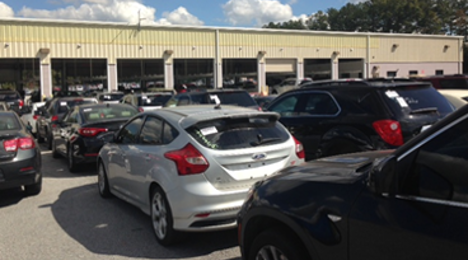Want to be savvy seller? Consider condition reports

A Manheim vehicle inspection center. Photo credit: Manheim.
As I walk through auction lanes on sale day, at locations across the country, I see a lot of dealers multi-tasking. Buyers are seamlessly using cell phones to gather information about vehicles lined up outside the lanes, accessing mobile apps to make offers via simulcast, and bidding on the car that is live on the block in front of them.
A glance at the screens above each auction block shows the competition consists of more than dealers present in the lane. A large online audience, participating via Simulcast and mobile, is in on the action remotely.
To make the most of these multi-tasking buyers, condition reports make all the difference and are a highly economical way for sellers to get more money out of sale day.
Dealers buying online, whether at a computer or with a mobile device, tend to look at listings with condition reports first, making those vehicles more popular and likely to sell faster. In fact, Manheim research shows that vehicles with condition reports sell four times faster.
Buyers who may be hesitant about buying online, without the opportunity to “kick the tires” on a vehicle before purchase, appreciate the availability of a condition report. Moreover, condition reports reduce potential headaches for sellers and buyers since vehicles that have them show a 37-percent decrease in arbitrations, according to Manheim data.
For less than the cost of a steak dinner, a condition report will more than pay for itself on the auction block, representing a significant return on investment. The proof is in the numbers. Manheim clients, for example, are three times more likely to purchase a vehicle with a condition report and vehicles that have a condition report sell for 20 percent more than cars that do not.
While many vehicles listed online for sale may have a photo available, only about half include condition reports. Savvy sellers will use condition reports to their advantage and get better conversion rates for the sale.
Not all condition reports are created equal, however. Assessments should cover the vehicle inside and out, from visible frame damage and paint to obvious mechanical damage and tires. The report should always include images, a vehicle description and reconditioning recommendations. Inspection grades should be easy to find and review prior to an auction, and used in conjunction with the full condition report.
Today, 70 percent of large dealers and 46 percent of small to midsize dealers use real-time data about a vehicle’s current condition to make more informed purchasing decisions, according to Manheim data.
As the industry continues to evolve to better meet dealer and seller needs, condition reports will prove to be one of the most useful tools for building dealer confidence in transactions, stimulating sales and driving optimal prices.

 View The Latest Edition
View The Latest Edition

